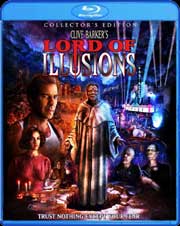 LORD
OF ILLUSIONS (1995) Blu-ray
LORD
OF ILLUSIONS (1995) Blu-rayDirector: Clive Barker
Scream Factory/Shout! Factory
 LORD
OF ILLUSIONS (1995) Blu-ray
LORD
OF ILLUSIONS (1995) Blu-rayClive Barker's third – and to date last – theatrical feature finally hits Blu-ray in its director's cut courtesy of Scream Factory's special edition which also features the stateside digital debut of the theatrical cut.
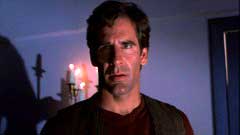
Forever drawn towards the supernatural, New York private detective Harry D'Amour (Scott Bakula, TV's QUANTUM LEAP) has recently achieved unwanted recognition over his investigation into an exorcism of a seemingly possessed Brooklyn boy. Needing a change of scene, he heads to Los Angeles to catch salesman Tapert (SAVAGE STREET's Johnny Venocur) in the act of insurance fraud. When he follows Tapert to a fortune teller, he unwittingly stumbles upon the grisly ritual torture of Quaid (Joseph Latimore, OUTBREAK) by magician Butterfield (Barry Del Sherman, THERE WILL BE BLOOD) and his almost subhuman partner Miller (Jordan Marder, VIRTUOSITY). Before Quaid dies, he warns Harry that "The Puritan" is coming. Although unnerved, Harry's interest in the murder ends there until he is contacted by Dorothea (Famke Janssen, X-MEN), the wife of master illusionist Philip Swann (Kevin J. O'Connor, THE MUMMY remake) who believes her husband is afraid of something having to do with Quaid's death. Attending Swann's last Los Angeles gala performance, Harry and Dorothea look on with the audience in horror as Swann's escape attempt from a wheel of suspended swords which drop at timed intervals goes horribly awry (his fate recalling the Ten of Swords Tarot card Harry flips over on Quaid's table). He is not surprised to find Butterfield and Miller on the scene until they violently demand to know who killed Swann. Instead of returning to New York, Harry offers to continue the investigation for Dorothea even though Swann's devoted servant Valentin (Joel Swetow, SEE NO EVIL, HEAR NO EVIL) tries to pay him off. Although Swann did not have very many friends among his fellow magicians, especially among the inner circle at The Magic Castle presided over by Vinovich (Vincent Schiavelli, AMADEUS), but young escapologist Billy Who (the film's magic consultant Lorin Stewart) tells him of a figure only spoken of in whispers named Nix (Daniel Von Bargen, BASIC INSTINCT), an extraordinary magician who Harry comes to believe is "The Puritan". As Harry searches out Swann's other associates via Quaid's address book, he runs into literal dead ends until he comes to realize that Swann's illusions were the real thing and that Nix was something even more powerful. Meanwhile, Nix's Manson-esque followers have murdered their families and are converging on his desert compound as Butterfield seeks to engineer his resurrection.
 Even
if Clive Barker's higher-budgeted, more lavish NIGHTBREED and LORD OF ILLUSIONS
do not quite live up to the promise of HELLRAISER, they are not insubstantial
works. Expanding significantly upon his short story "The Last Illusion"
from the sixth volume of BOOKS OF BLOOD, LORD OF ILLUSIONS moves the setting
from New York to Los Angeles and amps up the film noir-ishness beyond Harry's
hardboiled detective to Dorothea's femme fatale and Swann's Bel Air mansion,
the sultrier cues of Simon Boswell's (DUST DEVIL) score as well as throwaway
remarks about "Old Hollywood" as well as setting Swann's performance
at the Pantages theater. Bakula is the ideal Harry while Janssen for all her
character's femme fatale trappings does what she can with what turns into a
damsel in distress (especially compared to her star-making turn as a Bond villainess
in GOLDENEYE and her bitchier genre role in the HOUSE ON HAUNTED HILL remake).
Character actors Von Bargen and O'Connor – who would get a showier genre
role in THE MUMMY – are interesting alternatives in roles that one imagines
embodied by more suave performers (at a time when Houdini's neuroses were not
widely discussed and sexual harassment and assault allegations did not follow
more contemporary examples around). The storyline is actually pretty straightforward
aside from Harry's realization that the stated distinction between magicians
and illusions is indeed true (which shouldn't be that far a stretch since he
already believes in demons); and the revelation of Nix's intentions should not
be that much of a shock. Quite a few interesting characters are introduced and
then dropped, including Stewart's magician, SONS OF ANARCHY's McNally Sagal
as a detective, some of the cultists – including a "Snake Man"
– as well as professional magician Billy McComb who provides Swann with
his "in" to Vinovich and his clique. J. Trevor Edmond (RETURN OF THE
LIVING DEAD 3, PUMPKINHEAD II: BLOOD WINGS) appears briefly in the prologue
as the younger version of Butterfield, and DANCING WITH THE STARS' Carrie Ann
Inaba is on hand as one of Swann's dancers (she was also in SHOWGIRLS the same
year for United Artists).
Even
if Clive Barker's higher-budgeted, more lavish NIGHTBREED and LORD OF ILLUSIONS
do not quite live up to the promise of HELLRAISER, they are not insubstantial
works. Expanding significantly upon his short story "The Last Illusion"
from the sixth volume of BOOKS OF BLOOD, LORD OF ILLUSIONS moves the setting
from New York to Los Angeles and amps up the film noir-ishness beyond Harry's
hardboiled detective to Dorothea's femme fatale and Swann's Bel Air mansion,
the sultrier cues of Simon Boswell's (DUST DEVIL) score as well as throwaway
remarks about "Old Hollywood" as well as setting Swann's performance
at the Pantages theater. Bakula is the ideal Harry while Janssen for all her
character's femme fatale trappings does what she can with what turns into a
damsel in distress (especially compared to her star-making turn as a Bond villainess
in GOLDENEYE and her bitchier genre role in the HOUSE ON HAUNTED HILL remake).
Character actors Von Bargen and O'Connor – who would get a showier genre
role in THE MUMMY – are interesting alternatives in roles that one imagines
embodied by more suave performers (at a time when Houdini's neuroses were not
widely discussed and sexual harassment and assault allegations did not follow
more contemporary examples around). The storyline is actually pretty straightforward
aside from Harry's realization that the stated distinction between magicians
and illusions is indeed true (which shouldn't be that far a stretch since he
already believes in demons); and the revelation of Nix's intentions should not
be that much of a shock. Quite a few interesting characters are introduced and
then dropped, including Stewart's magician, SONS OF ANARCHY's McNally Sagal
as a detective, some of the cultists – including a "Snake Man"
– as well as professional magician Billy McComb who provides Swann with
his "in" to Vinovich and his clique. J. Trevor Edmond (RETURN OF THE
LIVING DEAD 3, PUMPKINHEAD II: BLOOD WINGS) appears briefly in the prologue
as the younger version of Butterfield, and DANCING WITH THE STARS' Carrie Ann
Inaba is on hand as one of Swann's dancers (she was also in SHOWGIRLS the same
year for United Artists).
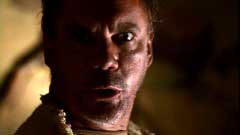
The slick cinematography of Rohn Schmidt – who got his start on ultra-low budget MIRROR OF DEATH and BLOODSPELL before moving on to working with Roger Corman in the nineties – varies from the warm to scorching hues of the desert to the noir-ish low key Los Angeles interiors and exteriors to the saturated primaries of Swann's stage show, and gives the film an even more lavish feel than Robin Vidgeon's work on NIGHTBREED. The make-up effects work was parceled among a number of notable effects houses. Nix's make-up and resurrection was the work of Steve Johnson (NIGHT OF THE DEMONS) and the "primordial meltdowns" seen by Swann and later Harry were the work of Tony Gardner (DARKMAN), while the day-to-day gore effects were executed by KNB Efx Group (IN THE MOUTH OF MADNESS) and Bob Keen's Image Animation (HELLRAISER). The visual effects were primarily the work of Gene Warren's Fantasy II Film Effects (LADY IN WHITE) and a host of burgeoning digital visual effects houses. Boswell's diverse score includes choral dirges a la his DUST DEVIL score, synths that recall his Italian works, flutes a la SANTA SANGRE, along with noir-ish saxophones and elegant piano themes (Boswell was also supposed to score HELLRAISER: BLOODLINE which eventually went to Daniel Licht). The soundtrack also features the brief inclusion of Boswell's song "Imagination" which he wrote and performed in the eighties and featured in his soundtrack for the Lamberto Bava "Brivido Giallo" TV movie GRAVEYARD DISTURBANCE (it was also featured in Michele Soavi's THE CHURCH which was otherwise scored by Keith Emerson and Goblin) along with Erasure's cover of Burt Bacharach's "Magic Moments" and Diamanda Galas' odd take on Arthur Schwartz's and Howard Dietz's "Dancing in the Dark".
 While
United Artists' other 1995 hit SHOWGIRLS was released with an NC-17 rating,
LORD OF ILLUSIONS had to be cut down for an R-rating with Barker going back
and forth with the MPAA; however, the twelve minute difference between the R-rated
theatrical version and the director's cut has more to do with the studio's desire
for a simpler, less noir-ish picture than what Barker had envisioned. Released
on tape by MGM in both R-rated and unrated director's cut editions (and on laserdisc
in the director's cut with a commentary by Clive Barker and other bonus features),
LORD OF ILLUSIONS has heretofore only been available on DVD stateside in its
director's cut (MGM owns the worldwide rights and the only release of the theatrical
cut appears to be their French release). An early but satisfying release, MGM's
domestic DVD featured the director's cut, the commentary, an isolated track
of Boswell's score (in Dolby Digital 5.1), deleted scenes with commentary, and
the film's trailer. Whereas Barker fans had to purchase the limited edition
of NIGHTBREED to get the theatrical cut (which was made available from Warner
Bros. whose rights did not include the director's cut), Scream Factory's LORD
OF ILLUSIONS is a two-disc set featuring both the director's cut and theatrical
cut (the earlier UK Blu-ray release from 101 Films features the theatrical cut
in HD but the director's cut in SD only).
While
United Artists' other 1995 hit SHOWGIRLS was released with an NC-17 rating,
LORD OF ILLUSIONS had to be cut down for an R-rating with Barker going back
and forth with the MPAA; however, the twelve minute difference between the R-rated
theatrical version and the director's cut has more to do with the studio's desire
for a simpler, less noir-ish picture than what Barker had envisioned. Released
on tape by MGM in both R-rated and unrated director's cut editions (and on laserdisc
in the director's cut with a commentary by Clive Barker and other bonus features),
LORD OF ILLUSIONS has heretofore only been available on DVD stateside in its
director's cut (MGM owns the worldwide rights and the only release of the theatrical
cut appears to be their French release). An early but satisfying release, MGM's
domestic DVD featured the director's cut, the commentary, an isolated track
of Boswell's score (in Dolby Digital 5.1), deleted scenes with commentary, and
the film's trailer. Whereas Barker fans had to purchase the limited edition
of NIGHTBREED to get the theatrical cut (which was made available from Warner
Bros. whose rights did not include the director's cut), Scream Factory's LORD
OF ILLUSIONS is a two-disc set featuring both the director's cut and theatrical
cut (the earlier UK Blu-ray release from 101 Films features the theatrical cut
in HD but the director's cut in SD only).
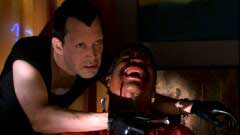
The 1080p24 MPEG-4 AVC 1.85:1 transfer of the director's cut (121:32) is looks superficially good for the most part with highlights no longer blowing out (like Dorothea's white clothing during her first meeting with Harry and the marquee at the Pantages), and highly saturated scenes (the introduction to Swann's act for instance) less smeary than the DVD and drawing more attention to the minutiae of Stephen Hardie's (NIGHTBREED) production design. It's not as eye-popping a presentation as MGM's Blu-ray of SHOWGIRLS (but we can probably only blame that to a degree on Barker's film being made at roughly a quarter of the budget of the Verhoeven film) with some long shots looking a bit dull. Some of the now-dated CGI and visual effects call more attention to themselves than on DVD, with the actor or the environment (whichever is the background element) looking flatter than the foreground, and minute black specks are also evident during film opticals like dissolves and fades (including the final shot). A quick look at the theatrical cut (108:53) reveals a similar but seemingly cleaner transfer. The film was originally mixed in DTS Stereo (a Dolby Stereo-compatible matrixed stereo surround format), and even as early as MGM's 1996 laserdisc it was remixed to Dolby Digital 5.1 (the matrixed surround mix was included on the disc's digital tracks). Scream Factory's Blu-ray features the 5.1 mix as well as a 2.0 track – both in DTS-HD Master Audio – on both cuts of the film. Optional English subtitles are also included for both cuts.
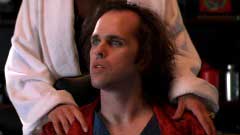 There
is not much in the way of new extras for the film in this collector's edition.
The theatrical trailer (2:39) appropriately accompanies the theatrical cut on
disc one with the bulk of the extras on director's cut disc. First up is "A
Note from Clive Barker" which is not a video introduction but a series
of text screens from a 1995 statement the director made about the director's
cut of the film. Carried over from the earlier releases is the audio commentary
in which Barker mentions the opening text screen was added after preview screenings,
the dry humor in some of the more horrific scenes, points out the visual allusions
to death and magic in the production design, as well as his preference for compositions
full of information for the viewers to take in. He speaks of Harry D'Amour as
his alter ego, and points out that Harry's tattoos were used to ward off evil
(Barker was not intending to include them until Bakula read EVERVILLE and liked
the idea). He also discusses his battles with the MPAA over how many frames
needed to be removed in order to not corrupt the soul of the American viewer
as well as the pacing cuts to the theatrical version. Barker is candid about
what he feels did not work and still proud of other bits (including the introduction
to the stage show which he likens to old Hollywood movies rather than Vegas
floor shows). While it is an interesting listen, he could have used a moderator
to prompt him about the film in the context of his other works and its themes.
There
is not much in the way of new extras for the film in this collector's edition.
The theatrical trailer (2:39) appropriately accompanies the theatrical cut on
disc one with the bulk of the extras on director's cut disc. First up is "A
Note from Clive Barker" which is not a video introduction but a series
of text screens from a 1995 statement the director made about the director's
cut of the film. Carried over from the earlier releases is the audio commentary
in which Barker mentions the opening text screen was added after preview screenings,
the dry humor in some of the more horrific scenes, points out the visual allusions
to death and magic in the production design, as well as his preference for compositions
full of information for the viewers to take in. He speaks of Harry D'Amour as
his alter ego, and points out that Harry's tattoos were used to ward off evil
(Barker was not intending to include them until Bakula read EVERVILLE and liked
the idea). He also discusses his battles with the MPAA over how many frames
needed to be removed in order to not corrupt the soul of the American viewer
as well as the pacing cuts to the theatrical version. Barker is candid about
what he feels did not work and still proud of other bits (including the introduction
to the stage show which he likens to old Hollywood movies rather than Vegas
floor shows). While it is an interesting listen, he could have used a moderator
to prompt him about the film in the context of his other works and its themes.
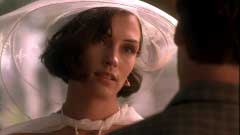
The two behind the scenes featurettes are new in the sense that they have not been included on previous releases, but they consist of old EPK material newly augmented with clips from the film and split-screen comparisons. "A Gathering of Magic" (17:51) is a concise vintage featurette with remarks from Barker, producer JoAnne Sellar, and stars Bakula, Janssen, and Von Bargen. Barker talks about the origin of the Harry D'Amour character and his desire to make the film half detective story and half horror with a protagonist drawn to the supernatural rather than a victim of circumstance. He also reveals how upon seeing Bakula in costume on set the first day that he realized that the actor was who he had been writing about. Sellar comments on how Barker's decisiveness on the set saves immeasurable time and money (she knows of what she speaks having gotten her start producing Richard Stanley's HARDWARE and the even more troubled DUST DEVIL) while Bakula talks about the challenge of playing the character faithfully for Barker and his faithful readers while figuring out the character according to his training. Janssen discusses the challenge of acting against effects elements that were not present on set and Barker's attempts to describe them for her (as well as how different they did look in the finished film from what she imagined on set). Von Bargen discusses initially turning down the project after skimming through the script and noting the dark nature of the character until he got a better sense of Nix's motivations.
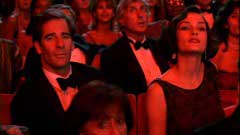 The
"Illusion of Reality" (61:56) is a meandering but informative montage
of behind the scenes video including some excerpted in the above featurette.
In addition to remarks from Barker, Bakula, Janssen, and Von Bargen, Stewart
discusses his contributions to the stage magic (including the challenge of designing
illusions that seemed appeared to be beyond the capabilities of illusionists
yet achievable as stage illusions for the camera). KNB's Howard Berger and Wayne
Toth also discuss the make-up effects applications while joking around with
actors. More interesting than split-screen comparisons of storyboards and the
finished film or behind the scenes video of Barker directing the lead actors
with the finished scenes is video of Barker addressing the featured players
and extras for the cult scenes (working them through emotional various stages
while giving them the freedom to realize them at their own pace and play off
one another).
The
"Illusion of Reality" (61:56) is a meandering but informative montage
of behind the scenes video including some excerpted in the above featurette.
In addition to remarks from Barker, Bakula, Janssen, and Von Bargen, Stewart
discusses his contributions to the stage magic (including the challenge of designing
illusions that seemed appeared to be beyond the capabilities of illusionists
yet achievable as stage illusions for the camera). KNB's Howard Berger and Wayne
Toth also discuss the make-up effects applications while joking around with
actors. More interesting than split-screen comparisons of storyboards and the
finished film or behind the scenes video of Barker directing the lead actors
with the finished scenes is video of Barker addressing the featured players
and extras for the cult scenes (working them through emotional various stages
while giving them the freedom to realize them at their own pace and play off
one another).
 The
deleted scenes with non-optional commentary by Clive Barker (3:21) are carried
over from the DVD and mainly focus on some of the sights Swann's team encounter
at the compound in the opening (including one bit that only survives in the
director's cut as a flash of Dorothea's nightmare later in the film). The interview
with storyboard artist Martin Mercer (11:54) is the sole newly-filmed extra
in which he discusses the process of developing the visual style of the film
in collaboration with Barker, visiting locations with him and taking photographs
over a six month period. Barker himself sketched frames extensively with Mercer
filling in the action (on earlier films, Barker had only storyboarded effects
sequences but the felt the need to do the entire film here because of its scope
and the relatively modest twelve million dollar budget. An extensive photo gallery
(15:51) is included, but sadly missing from the Blu-ray is the film's isolated
score track (which featured Boswell cues not included on the soundtrack CD such
as the synth intro to Swann's act). Presumably fans of the film have the MGM
DVD for that extra (or perhaps a more complete promo or grey market edition
of the score). While the LORD OF ILLUSIONS package pales in comparison to what
Scream put together for NIGHTBREED, it is otherwise perfectly respectable. (Eric
Cotenas)
The
deleted scenes with non-optional commentary by Clive Barker (3:21) are carried
over from the DVD and mainly focus on some of the sights Swann's team encounter
at the compound in the opening (including one bit that only survives in the
director's cut as a flash of Dorothea's nightmare later in the film). The interview
with storyboard artist Martin Mercer (11:54) is the sole newly-filmed extra
in which he discusses the process of developing the visual style of the film
in collaboration with Barker, visiting locations with him and taking photographs
over a six month period. Barker himself sketched frames extensively with Mercer
filling in the action (on earlier films, Barker had only storyboarded effects
sequences but the felt the need to do the entire film here because of its scope
and the relatively modest twelve million dollar budget. An extensive photo gallery
(15:51) is included, but sadly missing from the Blu-ray is the film's isolated
score track (which featured Boswell cues not included on the soundtrack CD such
as the synth intro to Swann's act). Presumably fans of the film have the MGM
DVD for that extra (or perhaps a more complete promo or grey market edition
of the score). While the LORD OF ILLUSIONS package pales in comparison to what
Scream put together for NIGHTBREED, it is otherwise perfectly respectable. (Eric
Cotenas)